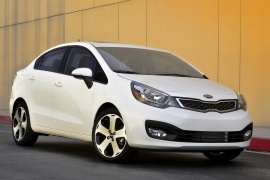KIA Rio Sedan Models/Series Timeline, Specifications & Photos
First production year: 2005
Engines: Diesel, Gasoline
Kia introduced the third generation of the Rio lineup in 2011 at the Geneva Motor Show, and the lineup consisted of a hatchback with three or five doors and a sedan.
The world financial crisis made more people cut their expenses when it came to purchasing a new car, and instead of going for expensive brands, they stormed the doors of Kia’s showrooms spread across the world. As a result, the Korean automaker was happy to provide vehicles with up to seven years of warranty and a tasteful new design imagined by the European designer Peter Schreyer, who led the styling department for the Korean automaker. Sales went through the roof, and a new line of products emerged. Some of them were built specifically for certain markets, such as the Rio Sedan, which was not available everywhere. But the Europeans had it.
Kia continued the production of a sedan version for the small-sized lineup Rio since there were still many customers who considered a three-box-shaped vehicle to be more appropriate for families than a hatchback. But, as expected, the Korean automaker made this version of the Rio based on the same platform as the rest of the hatchback-styled one. As a result, the front fascia of the 2011 Rio Sedan featured the same angular-looking headlights, slightly swept back towards the sides. The pinched grille suggested the “tiger-nose” design language imagined by Schreyer. From its profile, the main difference compared with the five-door hatchback was at the back, where the Sedan featured a trunk instead of a tailgate. Finally, the rear fascia revealed a set of corner-mounted taillights extended over the trunk lid.
The car’s interior was spacious enough for a small-sized sedan, and Kia tried to convince customers that the Rio Sedan was suitable for five adults. While the front seats could accommodate two full-grown adults, the bench seat placed in the rear could hardly get more than two adults due to the limited headroom and legroom. In front of the driver, the automaker installed the binocular-styled instrument cluster where the speedometer took center stage, and it was flanked by the tachometer on its left and by the fuel and temperature gauges on the right. Kia placed the CD-Radio on the center stack on the upper side, followed by the HVAC control panel underneath it. Behind the cabin, in the trunk, the automaker made room for up to 500 liters (17.7 cu-ft) of luggage.
Surprisingly, Kia offered the Rio Sedan with a very wide range of engines, from a 1.1-liter turbodiesel to a 1.6-liter gasoline powerplant. While the former was built mainly for fuel efficiency, the latter provided more performance. Still, it wasn’t possible to call the Rio a sports sedan. It was a small-sized family sedan that could provide mid-range features at a lower price.
The Kia’s smallest car was also their cheapest released by 2009.
While the Rio was not designed to turn heads, it wasn’t a an ugly car either. It was a good choice for people with a low budget and in need of a small city car for daily use. The Rio had a great fuel consumption and offered a stellar warranty.
The Rio was available in a sedan or a 4-door hatchback. The sedan came with 3 trim levels, the base, the LX and the SX.
The base sedan offered nothing more than 14-inch steel wheels and a 4-speaker stereo with CD and MP3 player.
The LX trim added air-conditioning, power steering, foldable rear seats and an AUX jack.
The top of the range, the SX added 15-inch alloy wheels, a leather wrapped steering wheels and new fabric upholstery.
While it’s true that it was a bit unusual to have a base model without air conditioning for 2009, we must remember that it was one of the cheapest cars available on the market.
Stand-alone features included keyless entry, tweeter speakers and the 16-inch alloys exclusively available for the SX trim level.
The Rio was equipped with the only engine available, a 1.6-liter developing 110 hp. It could be mated with a 5-speed manual or a 4-speed automatic transmission - excluding the base trim level that only came with the manual gearbox.
Safety wise, front and side airbags along with side curtain airbags were standard. Antilock disc brakes were available for the higher trims.
While the Rio scored 4 stars out of 5 for the driver and the passenger protection, the side-impact test gave the small sedan a poor score.
Kia grew in the U.S. market with the introduction of the first generation Kia Rio in 2000. While it was a low-cost car, it managed to offer great reliability for an attractive price.
In 2006, Kia raised the bar with the Kia Rio sedan and even got the “Most Improved New Vehicle for 2006” awarded by Autobytel.
Why? Because the new Kia Rio offered class-leading power and interior room, as well as enhanced safety with six standard airbags, including full-length side-curtain airbags.
The improved interior volume was achieved with the longer wheelbase and the width and height increase.
Aesthetically, the small Rio had an European exterior design that inspired sportiness with a bold appearance.
Inside, the new Rio was fitted with improved quality materials. Besides the cloth upholstery that incorporated a sporty-looking mesh fabric, the cabin was fitted with an 8-way adjustable driver’s seat and a central armrest to enhance comfort.
The numerous storage space available inside the cabin added to the practicality of the Rio, as well as the dual 12V power outlets and a shopping bag hook placed on the back of the front passenger seat.
The new Kia Rio sedan offered more standard power than any vehicles in its class, with the new 1.6-liter DOHC engine that produced 110 hp and 107 lb.-ft of torque. Fuel consumption was also improved by 20%.
For 2006, the sedan in its base trim level offered, 14-inch tires with full wheel covers and power steering with tilt, while the rio LX added air conditioning, larger 14-inch tired and a 60/40 split folding rear seat.
Other stand-alone options were also available at an extra cost, such as power windows, power door locks, BAS, a 4-speed automatic transmission and others.


